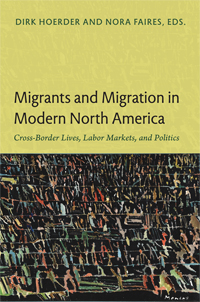|
“Paying Attention to Moving Americans:
Migration Knowledge in the Age of Internal Migration,
1930s-1970s”
by James N. Gregory
This essay is published in Migrants and Migration in Modern North America: Cross-Border Lives, Labor Markets, and Politics in Canada, the Caribbean, Mexico, and the United States, eds. Dirk Hoerder and Nora Faires (Durham: Duke University Press, 2011)
|
| 
James N. Gregory has published two books and several articles (four on-line below) on the Great Migration and other American migrations
The Southern Diaspora: How The Great Migrations of Black and White Southerners Transformed America (Chapel Hill: University of North Carolina Press, 2005). Winner of the 2006 Philip Taft Labor History Book Prize.
American Exodus: The Dust Bowl Migration and Okie Culture in California (New York: Oxford University Press, 1989).Winner of the 1991 Ray Allen Billington Prize from the Organization of American Historians; winner of the 1990 Annual Book Award from the Pacific Coast Branch of the American Historical Association
“Paying Attention to Moving Americans: Migration Knowledge in the Age of Internal Migration, 1930s-1970s,” Migrants and Migration in Modern North America: Cross-Border Lives, Labor Markets, and Politics in Canada, the Caribbean, Mexico, and the United States, eds. Dirk Hoerder and Nora Faires (Durham: Duke University Press, 2011)
“The Second Great Migration: An Historical Overview,” African American Urban History: The Dynamics of Race, Class and Gender since World War II, eds. Joe W. Trotter Jr. and Kenneth L. Kusmer (Chicago: University of Chicago Press, 2009)
"Southernizing the American Working Class: Post War Episodes of Regional and Class Transformation," Labor History 39 (May 1998). A Labor History Forum article with comments by Thomas Sugrue, Grace Elizabeth Hale, and Alex Lichtenstein, and response by author
"The Southern Diaspora and the Urban Dispossessed: Demonstrating the Census Public Use Microdata Samples." Journal of American History 82 (June 1995).
"Dust Bowl Legacies: The Okie Impact on California 1939-1989" California History (Fall 1989) |
This essay explores the production and dissemination of "migration knowledge" by social scientists, historians, and journalists over the course of the 20th century, illuminating the relationship between academic knowledge and public knowledge and highlighting the mid century decades when internal migration was the principal focus of attention.
---
Two mass-market books reached bookstores in late 1972 and early 1973: A Nation of Strangers by Vance Packard, a journalist and pop sociologist, and The Moving American by George Pierson, a historian at Yale. Both called attention to what the authors considered very high rates of geographic mobility, echoing a pattern of journalistic and academic literature that for several decades had focused on internal migration, relocations of Americans across state lines and from farms to cities to suburbs. Packard, a chronicler of social trends, considered mobility a phenomenon that Americans needed to watch and worry about, as the title’s reference to “strangers” indicates. Using terms like “restless” and “uprooted,” he argued that geographic mobility had the potential to harm communities, families, and personalities and to produce loneliness, disorientation, and social fragmentation.1 The historian Pierson celebrated the mobility of Americans, emphasized its continuity over time, and argued that it was part of “the American character.” Ocean- and mountain-crossing pioneers had built his America, and to him geographic mobility showed a spirit of yearning, ambition, and self-reinvention that boded well for the nation’s future.2
Reflecting two different disciplinary traditions—sociology and social dislocation, history and American character—these books capped a long period of public and academic interest in moving Americans. To read them is to revisit a time when internal migration competed with cross-border immigration for headlines and when multiple institutions of knowledge production and knowledge circulation focused on the problem of mobility. The period from the 1930s to the 1970s was the golden age of migration research, when public funds and public interest fueled studies by sociologists, demographers, economists, and historians; and when journalists, novelists, and mass entertainment industries spread scholarship’s results beyond campus walls. The interface between scholars and publics at that time is worthy of our consideration. Migration scholars today—at a moment when more people around the world are in motion and living outside natal countries than at perhaps any time in human history—seem less capable of influencing broad publics than in the age of internal migration.
This chapter explores the rhythms of migration studies. It traces the shifts that have occurred in the relationship between producers of migration research and the institutions of communication that can give added social and political significance to this research. It will also discuss the relationship between two of the disciplines that produce migration studies. Historians and social scientists have not only differed in methods and findings but also interacted on different terms with the popular media. Analyzing the differences can help us think about what might be done to widen the channels of public access for current studies. Doing so is important, because migration knowledge is itself significant in the social systems that condition and respond to migration. When it circulates widely, migration research helps set the terms for migration decisions, migration receptions, migration politics, and also migrant identity formation.3
The Age of Internal Migration
Migration was once front-page news. In nearly every mass medium, from newspapers to magazines, to radio and television, to film and fiction, even popular music, the topic of moving Americans captivated the public. The fiction is perhaps best remembered today. Novels like The Grapes of Wrath, Native Son,Invisible Man, Go Tell It on a Mountain, The Dollmaker, and On the Road remind us of a time when migration was treated as a complex social and personal issue and when mobility was thought to be emblematic of some central part of the American experience.4 The patterns of popularity show up in the Readers’ Guide to Periodical Literature, which has been indexing magazine articles since the 1890s.
|